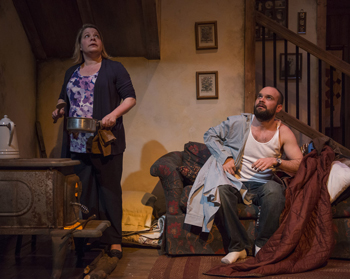
The "bunker play" literary genre proposes a microcosmic society characters confined in restrictive quarters under duress arising from an outside threat. In Conor McPherson's The Birds (adapted from the short story by Daphne DuMaurier), what precipitates his three refugees securing shelter in an abandoned house on the New England coast are a series of concerted attacks by flocks of, literally, angry birds.
We never see the airborne invaders breach the defenses of the makeshift fortress. Indeed, the onslaught is visible only as clumps of bloody plumage affixed to the barricades on the doors and windows. This leaves the suspense generated by the prospect of nature turning on humankind to be intimated entirely through the frenzied cries of the besieging armies.
Creating a chorus of squawking Kamikaze fighters involves more than simply transcribing the chirps and trills of caged canaries, declares sound designer Stephen Ptacek. "The birds should be more than just an abstract menace. I wanted to create a language for them, so that audiences would be aware of what was occurring outside. For example, there are a couple moments when the people in the house forget to whisper and start speaking in loud voices. I found a recording of Lapwings—they make this really eerie kind of yapping noise—that I mixed with the noise of flapping wings and crunching pebbles to convey the impression of the birds being suddenly alerted to the presence of warm-blooded prey inside this dusty cabin."
At the beginning of the play, the aggressors are mostly seagulls, but later, audiences can recognize the distinctive calls of crows, grackles and even owls. Is this because additional allies—perhaps from farther inland—are joining in the attack? "Kevin [Kingston], our director, and I discussed the notion of predatory birds crowding out the less aggressive species," Ptacek explains, "but hearing coastal birds at the top of the show helps establish geographical location, as well as underscore the pattern of the birds attacking with the tide. That said, I decided early on not to adhere too strictly to actual migration patterns."
Consolidating the individual parts also demanded unorthodox measures. "Normally, I'd mix all the bird calls into a single file, which I'd then fade in and out to suggest the ebb and flow of battle—but some of them are only a minute long, so soon you'd get the same sequence repeated over and over. What I did, instead, was to separate the different 'voices' to lend variety to the storytelling aspect."
Ornithology gone feral isn't just vocal intimidation, however—it's also beaks, claws and feathered projectiles scratching at doors and battering windows. "Most birds are so small that nobody would notice them smashing into the wall of a 200-seat theater, but if we had amped it up too much, it would have sounded like we were hurling buzzards at the exterior. What turned out to be scarier was to focus on what the birds were hitting—like using an aluminum baseball bat to simulate a dive into a roof gutter, or a slamming screen door for a crash into wooden siding."
What matters is not exact reproduction, Ptacek reminds us, but how skillfully an audience's reality can be guided by manipulation of the sonic landscape through subconscious sleight-of-hand. An especially alarming crash in mid-show, he reveals, was produced by a bicycle wheel dropped to the floor. "When the uneasiness emerges naturally out of the onstage action, and you have crows and lapwings and bluejays and what-all screeching at you in the dark—well, a great big, loud, bouncing bicycle tire can sound like the end of the world."
The Birds runs at Theater Wit through July 19.
Mary Shen Barnidge
Contributing Writer

 Follow Us On Twitter
Follow Us On Twitter